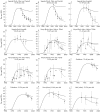Declines in HIV prevalence can be associated with changing sexual behaviour in Uganda, urban Kenya, Zimbabwe, and urban Haiti
- PMID: 16581753
- PMCID: PMC1693572
- DOI: 10.1136/sti.2005.016014
Declines in HIV prevalence can be associated with changing sexual behaviour in Uganda, urban Kenya, Zimbabwe, and urban Haiti
Abstract
Objective: To determine whether observed changes in HIV prevalence in countries with generalised HIV epidemics are associated with changes in sexual risk behaviour.
Methods: A mathematical model was developed to explore the relation between prevalence recorded at antenatal clinics (ANCs) and the pattern of incidence of infection throughout the population. To create a null model a range of assumptions about sexual behaviour, natural history of infection, and sampling biases in ANC populations were explored to determine which factors maximised declines in prevalence in the absence of behaviour change. Modelled prevalence, where possible based on locally collected behavioural data, was compared with the observed prevalence data in urban Haiti, urban Kenya, urban Cote d'Ivoire, Malawi, Zimbabwe, Rwanda, Uganda, and urban Ethiopia.
Results: Recent downturns in prevalence observed in urban Kenya, Zimbabwe, and urban Haiti, like Uganda before them, could only be replicated in the model through reductions in risk associated with changes in behaviour. In contrast, prevalence trends in urban Cote d'Ivoire, Malawi, urban Ethiopia, and Rwanda show no signs of changed sexual behaviour.
Conclusions: Changes in patterns of HIV prevalence in urban Kenya, Zimbabwe, and urban Haiti are quite recent and caution is required because of doubts over the accuracy and representativeness of these estimates. Nonetheless, the observed changes are consistent with behaviour change and not the natural course of the HIV epidemic.
Conflict of interest statement
Competing interests: none declared
References
-
- Joint United Nations Programme on AIDS Reference Group on Estimates Modelling and Projections Trends in HIV incidence and prevalence: natural course of the epidemic or results of behavioural change?. Geneva: UNAIDS, 1999
-
- Stoneburner R L, Low‐Beer D. Population‐level HIV declines and behavioral risk avoidance in Uganda. Science 2004304714–718. - PubMed
-
- Rojanapithayakorn W, Hanenberg R. The 100% condom program in Thailand. AIDS 1996101–7. - PubMed
Publication types
MeSH terms
Grants and funding
LinkOut - more resources
Full Text Sources
Medical




